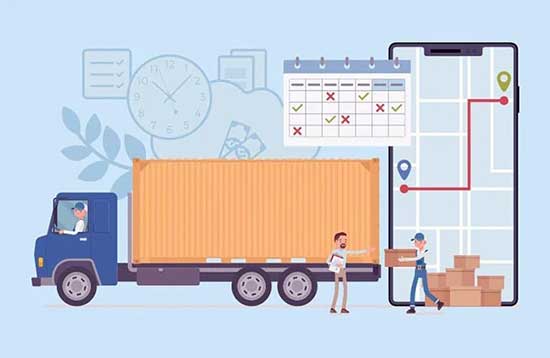
Breaking Barriers and Accelerating Growth with Inbound Logistics
Published :

One of the most dynamic, complex and chaotic business processes is the inbound logistics management. Despite the importance of robust supply chains, most businesses across the planet struggle with conventional supply chain practices that are inefficient and lack the transparency and speed that is needed. However, as a modern business, there is no need to really suffer from such inefficiencies in the digital age. Today, advanced logistics software can help you increase the profit margin and reduce operational costs for your fleets.
By inbound logistics, we refer to the supply network that enables delivery of products or materials to your business location. A strong inbound logistics network integrates everything that a business needs to transport, store and deliver goods to its location. Depending on the industry, there could be different types of products and materials that a business needs to procure from suppliers.
For instance, it could be raw materials for a manufacturer and finished goods for a retailer or distribution business. While most businesses focus on building strong outbound logistics chains that help them supply their products, a lot of entrepreneurs make the mistake of not giving equal emphasis to inbound logistics, and as the pandemic highlighted, this neglect can lead to business disruption. That’s why optimization of inbound logistics is absolutely crucial for smooth running of business operations.
However, the complexities and multiple touchpoints involved in the process make inbound logistics quite complex. That’s why you need the best logistics software support to have complete and real-time visibility of your entire logistics network and its operational status. By having complete visibility and control, you can streamline operations, inventory management, supply chain planning, and reduce the cost of logistics. To make this happen, a holistic inbound transport management system has to be put in place which can streamline the entire end-to-end logistics chain. A business needs to develop delivery strategies collaboratively with the suppliers to ensure a strong inbound logistics system. This should include:
Developing delivery strategies collaboratively – The delivery strategies should be formed in consultation with the suppliers in a way that benefits both. The advanced transport management software would use integrated analytics and GPS tools to identify optimal route maps and it can also enable optimal cargo-vehicle matching to ensure that the right load is matched with the right vehicle type to ensure safe and smooth transportation.
Establishing compliance standards - Another major step that can be taken to optimize the inbound supply chains is to establish compliance standards for your vendors that can be automatically tracked and recorded by the software. The system would ensure that the entire logistics chain is monitored round the clock and variations in standards and failure to match compliance standards leads to penalties for the vendors.
Lead Time: Handling Inventory is a crucial part of the manufacturing game. It should not be too high thereby increasing inventory costs or too low to disrupt production. The same parameter holds good for a retailer as well when the inventory should be optimal. Hence a Logistics platform should ensure that it integrates well with the inventory systems to understand when the right moment will be to procure based on the lead times for delivery.
Transport Optimization: While the industry buckles with tight capacity, there are instances where there are under-utilized capacities. With a robust Logistics platform, transportation planners can ensure every truck operates under optimum capacity thereby reducing the overall transportation costs.
An end-to-end Logistics platform like Ramco enables elimination of human errors through automation. Oversights such as incomplete documentation or loss of papers in transit can be overcome through digitization of the processes. Further, the integrated data analytics and AI tools will be able to pinpoint the areas where errors potentially occur. This would enable the supply chain managers to pay adequate attention to those areas and prevent costly errors. Another cost that most logistics operators bear is the cost of operating underutilized vehicle space. Half or 70% loaded trucks would still cost the same for the shipper. However, a digital transport management system would monitor each vehicle’s capacity and lead to optimum vehicle utilization. Thus, there will be fewer trips required resulting in cost savings.
Using best-in-class logistics software such as Ramco can help businesses dynamically control their entire inbound logistics network and optimize business operations and profitability. The smart cloud-based transport management system would use analytics to plug the gaps and improve efficiency alongside reducing operational costs and overheads.
Enterprise asset management (EAM) involves the management of mission critical assets of an organization throughout each asset's lifecycle. EAM is used to plan, optimize, execute, and track the needed maintenance activities with the associated priorities, skills, materials, tools, and information. The aim is to optimize the quality and utilization of assets throughout their lifecycle, increase productive uptime and reduce operational costs.
Enterprise asset management (EAM) involves the management of the maintenance of physical assets of an organization throughout each asset's lifecycle. EAM is used to plan, optimize, execute, and track the needed maintenance activities with the associated priorities, skills, materials, tools, and information.
The software helps in effective maintenance of assets through preventive, predictive, shutdown and breakdown maintenance strategies. The system also helps enterprises mitigate equipment risks by enhanced safety standards. The streamlined operations and improved asset performance helps organizations increase their investment effectiveness.
EAM is important because it helps organizations track, assess, manage and optimize asset quality and reliability. Asset intensive Organizations have hundreds, thousands, even millions of assets which needs to be maintained to maximize / optimize life of these assets to increase the return on investment.
The key features of effective EAM are:
Asset Intensive companies under the following Industries :
Contact us for a meeting and schedule a demo
This differs on case to case basis, based on the type of installation and unique industry specific requirements. Contact us for a meeting and schedule a demo.
This differs on case to case basis, based on the type of installation and unique industry specific requirements. Contact us for a meeting and schedule a demo.
Stay Connected, follow us on LinkedIn / Twitter to know more about EAM Software latest trends.

Ragunathan leads Go-to-Market and Branding for Ramco Systems’ Logistics product, bringing extensive experience in digital marketing and product launches. He has a proven track record of driving impactful strategies that deeply connect with target audiences. Passionate about solving complex problems, delivering scalable systems, and enabling organizational growth through innovation, he excels at collaborating with cross-functional teams. Ragunathan values continuous learning and is committed to building practical solutions that deliver real value.

All Rights Reserved. © Copyright 2024. Ramco Systems.